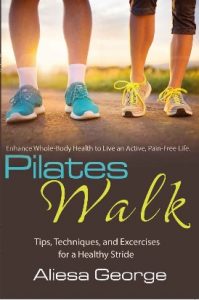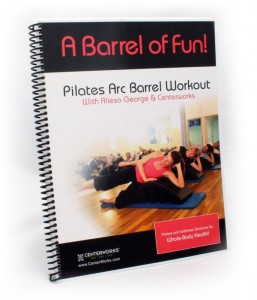Why Hips and Pelvic Placement Matter for Healthy Movement and How Pilates Exercises Can Benefit You
 Are you dealing with annoying chronic aches and pains, or have you experienced an injury that seems impossible to fully recover from? Body posture and proper pelvic placement play a HUGE role in how easy (or challenging) it might be to maintain your whole-body health. Doing Pilates can be an excellent way to explore exercises to help you improve pelvic placement, enhance posture and body awareness, and put your pelvis where it belongs to help develop healthy movement habits for better functional movement.
Are you dealing with annoying chronic aches and pains, or have you experienced an injury that seems impossible to fully recover from? Body posture and proper pelvic placement play a HUGE role in how easy (or challenging) it might be to maintain your whole-body health. Doing Pilates can be an excellent way to explore exercises to help you improve pelvic placement, enhance posture and body awareness, and put your pelvis where it belongs to help develop healthy movement habits for better functional movement.
If injured, we compensate. It’s not just the injury that’s the problem, it’s all the ways we compensated during the injury that reinforces bad body mechanics, increases wear and tear, and makes it more likely that we’ll get stuck in a pain-injury cycle. Who do you know that’s experienced the domino effect of the knee injury leading to the hip pain, leading to a low back problem? Or a shoulder injury, leading to the upper neck and back pain, then lower back and hip pain, and other related chronic aches and pains (that they might not even realize are related!). How about that fall you took as a kid when you landed hard on your tailbone. How long do you think your body has been compensating for that?
I had a new client this week who complained of a tight hamstring. She’s younger, has done lots of stretching, and just can’t get it to release. Her assumption was, “My hamstring is tight, it will always be tight, there is nothing I can do to fix it.” In less than an hour of discussing her posture, breathing, and pelvic placement, she began to realize that there are things she CAN do. The habits she’s been using to stand, sit, and move are contributing to the problem. With a better understanding of how to change your habits and get the right things working correctly, you can improve just about anything!
Another new client had a shoulder injury many years ago. Her shoulder still hurts, nobody’s been able to totally “fix” it. And in addition, she’s now plagued with hand issues and severe carpal tunnel problems. She’s had carpal tunnel surgery once already that helped for a little while, but now she thinks it’s time to do it again. Looking at her posture, it’s easy to see why her shoulders and arms hurt! And while hand surgery might help, there is no way it’s going to be a long-term solution. I’m confident that when we fix her posture issues, there will be less nerve impingement, so the notion of more surgeries can go on the back-burner as a last-ditch option (Because surgery is not really “fixing” the problems causing the nerve impingement in the first place!). But who would think that correcting pelvic placement would matter for a shoulder problem? Trust me, it does!
Here’s a question for you — Who is paying attention to your posture and pelvic placement?
When you go to your doctor and complain of a pain anywhere in your body, how often do they look at the one specific spot you’re complaining about vs. how it should be integrating with the rest of your body?
When you do therapy or rehab, are the exercises focused on the parts or the whole? Because it might not be your quad/hamstring muscle balance that is causing your knee pain but rather your foot/ankle mechanics, the ability of your thigh to rotate inward and outward, freely, how over-grippy your hip flexors are, or functional hip mechanics and pelvis placement that really need to be addressed to help your knee bend and straighten without hurting. And this is just one example… Pick a body part!
Is anybody looking at what is going on above and below what hurts and then recommending exercises to correct or adjust the things that are out of balance everywhere?
Yes, I know there might be so much to pay attention to and improve that it can be a little overwhelming at first. But would you rather focus on the pain, pop a pill, schedule and expensive surgery, or focus on finding new ways to support yourself, improve strength, flexibility, and body mechanics by changing how you use your muscles to improve body alignment and start feeling better?
If you want to stay healthy, you’ve got to choose healthy habits. And sometimes that involves un-learning bad habits to replace them with better ones. Whether your aches and pains are above or below your pelvis, improving pelvic placement will improve posture, body mechanics, and help you find and use the right muscles to move without pain.
The first step to improving pelvic placement, is becoming aware of your posture habits and working to improve both posture and breathing. But muscle imbalances and old bad habits might make it challenging to stand tall. It will take movement to change muscle habits. It’s challenging to change standing still – which is why working diligently to improve balanced muscle development is so important. And this is a built-in feature of the Pilates system! When you get it right, it’s easier to move, your muscles and joints can start doing their job effectively, you will get stronger, more flexible, and quickly start to reduce or eliminate pain.
If it’s difficult for you to notice what you’re doing when you’re standing still – can you imagine what havoc is happening when you’re moving?
Possible Pelvic Placement Positions
In very un-technical terms, when you look at Pelvis Placement there are three basic positions your hips might be in:
- Tuck Butt
- Duck Butt
- Middle of the Road Butt

The Trouble with “Tuck Butt”
If your preference is to live your life in a “Tuck” butt position, here are a few ways this poor pelvis position is harming your health. First, your glutes are over-working as stabilizers. Second, this position shifts a lot of stress straight into the knees. Third, the ball of the thigh bone is jammed up into the socket – so it’s impossible to effectively get a good leg swing to the back when you walk.
“Tuck Butt” Pelvis Placement can lead to low back pain, knee pain, hip pain, and upper back, neck, and shoulder problems. With the hips in a posterior pelvic tilt, it pulls the low back out of it’s normal arch, glutes and legs are doing so much that the low abs get lazy. Because the low back tucked, the mid to upper back is likely trying to reverse its curve and arch more, making it impossible to get a deep breath into the bottom of the lungs. There is a chain reaction that goes all the way up. Because the natural curves of the spine are gone and the back is weak and out of position, the chest and upper trapezius muscles take over and pull the shoulders too far up and forward. I could go on… but I hope you get the point. If your normal posture position is to stand and sit with your butt tucked, it’s inhibiting functional movement. Sooner or later when your body can’t take it anymore, you can expect chronic aches and pains, or a more serious injury to occur.
The Difficulties of “Duck Butt”
If you’re comfort zone is a “Duck Butt” there’s a ton of stress on your low back and it’s harder to find your abs because your back wants to do all the work. Because you don’t have the support in the pelvis, chances are you live life overworking your chest, arms, and shoulders. Aside from the structural aches and pains, you might also experience digestion/bowel difficulties because all your internal organs are falling out to the front which means they’re not in position to function optimally. With a forward tilted pelvis, it is impossible to get a good leg swing to the back when you walk, so your gait will be compromised and the chain reaction of poor posture and bad pelvic placement begins…
“Duck Butt” Pelvis Placement can lead to similar low back, knee, hip, upper back, neck and shoulder pain issues but for different reasons. Because the pelvis is tilted too far forward, the lower back muscles end up on lock-down. The body weight is usually resting more on the heels with the knees locked. In trying to stand upright with the pelvis tilted forward, the shoulders will be too far back and may end up behind the hips – which throws the entire back into an arch. Instead of the three normal curves of the spine, there is one long arc (like a banana). Abdominals pooch out and the head shifts forward to counter balance the weight on the heels. Because the whole back is now inappropriately arched and the shoulder blades need a curve to rest on, the shoulders will hike up and round forward. Duck Butt pelvis placement people tend to have super-tight lower backs, usually have super tight quadriceps, and hip flexors that are working overtime. Know anybody that looks like this?
Remember I’m speaking in general terms here. Your pelvis placement might be creating other issues not mentioned above!
Here’s the deal. If your hips and pelvis aren’t living in the optimal position for movement, you will be unable to move efficiently, effectively, and without pain. Without good posture and the right muscle firing patterns it is almost impossible to maintain (or improve) your health. If you’re one of the millions of people struggling with low back pain, SI joint issues, hip, knee, or foot pain, there’s a very high probability that your posture and pelvic placement could use fine-tuning for new and better movement habits.
Sometimes the pelvis needs to be stabilized. Sometimes it needs to move into an arch, sometimes it needs to move into a c-curve or scoop. Sometimes both halves of the pelvis need to do something different at the same time (Gait and WALKING for example!)
Next couple of questions…
How are you going to improve your Pelvic Placement when you’re not sure:
- Which position the pelvis needs to be in?
- Is the pelvis supposed to be stable or mobile?
- What is MY pelvis doing and what do I need to do to fix it?
If you’ve been doing exercises that are supposed to be “good for you” but they’re not. or they hurt while you’re doing them, or you’ve been doing them for months and don’t see the improvements you’d hoped for – your pelvic placement, posture, breathing, and body mechanics might need to be adjusted to work effectively. Not everybody cues all this when they tell you to do every exercise in your workout!
When you understand the difference between tucking and scooping – and learn to scoop correctly when you need a posteriorly-tilted pelvis, you’ll have the right support to do exercises like the Pilates Roll Up.
When you understand how to tilt the pelvis forward and hinge from the hips effectively with good core support, you’re going to get big improvements in your hamstring flexibility, and significantly reduce stress on your lower back.
And when you understand how to stabilize the sacrum and mobilize each side of the pelvis independently – you’ll be well on your way to a healthier stride.
Ultimately it would be great to find, feel, and learn how to live with “Middle of the Road” butt as your neutral or functional pelvis position. Not too arched, not too tucked. There are a lot of other little details that can help you fine-tune your posture and figure out where this pelvic position is, and this is where working with a great Pilates teacher can help you figure it out.
How Can Pilates help Pelvic Placement?
I am such a huge fan of Pilates! Of course, teaching Pilates daily for the past 25 years has given me the opportunity to see how powerful it can be to connect mind, body, breathing, and movement. The Pilates equipment can help both support and assist developing new and better habits for pelvic placement. Because exercises are done lying on the back, side, belly, kneeling, standing, right-side up, and upside down, Pilates students are given the opportunity to learn how to organize the body and keep everything working well regardless of where they are in space. The spring resistance on the Reformer, Cadillac/Tower, and Chairs help the muscles learn to work and release properly, meaning that unlike lifting weights where it’s difficult in one direction and gravity does the work the other way, you must work to control the springs in both directions. Pilates Barrel exercises, especially the Pilates Arc Barrel can be fabulous for becoming more aware of pelvic placement, core support, and spine, shoulder, and hip mobility. There is so much variety with Pilates that it’s never boring, there is always something to focus on and endless variations and exercises to modify for those who are working their way out of pain or to challenge even the most highly skilled athlete.
That is why it’s a worthwhile investment to find a well-qualified Pilates teacher and take some private sessions. Having a well-trained and experienced set of eyes helping you become more aware of your good/bad habits, and helping you with specific exercises to improve pelvic placement, posture, breathing, and movement – can be worth every penny! It’s difficult sometimes to see, or feel what we’re doing on our own, and in a group class – you will miss out on some of the hands-on help you get with privates. Logically understanding what to do, and confidently knowing in your body that you can do it well takes time, practice, and a good movement mentor can help speed up the process. Exercise is designed to keep us healthy. But if your Pelvis isn’t in a good position to start with, it will be impossible to activate and strengthen the right muscles to keep you moving well – regardless of the exercise!
Are you ready to improve health and eliminate pain? It might be time to start paying more attention to your posture and pelvic placement.
*************
Take the Centerworks Posture Quiz and become more aware of your current posture habits.

I mentioned that gait and walking is an important activity that requires good pelvic placement and functional movement habits to get optimal benefits from. If you’re interested putting Pilates principles to work when you walk, (whether you’ve ever taken a Pilates lesson or not…) check out my Pilates-Walk book. It’s a simple system of tips, techniques, and exercises to break down the complicated aspects of improving gait to help improve your stride.

Another one of my favorite places to focus on pelvic placement is with the Pilates Arc Barrel. If you have an Arc Barrel at home, there are lots of great exercises you can do not only for your hips and pelvis, but to help your whole-body. Get yourself a Pilates Arc Barrel, then grab a copy of my book, A Barrel of Fun! Pilates Arc Barrel Workout and start practicing better pelvic placement to improve how you move, help enhance posture and help eliminate pain.


0 Comments